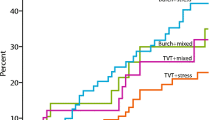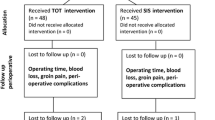Abstract
The purpose of this study was to compare the surgical outcome and attendant complications of the suprapubic arc (SPARC) sling and tension-free vaginal tape (TVT) procedures. Sixty-two women with genuine stress incontinence (GSI) alone or combined with pelvic prolapse less than International Continence Society (ICS) stage II were randomly allocated to either SPARC or TVT groups. A routine suprapubic ultrasonography was performed for all patients 1 day after the anti-incontinence operation. A comparison of the peri- and postoperative results comprising surgical outcomes and complications revealed no significant differences between the two groups. Although the difference in the rates of bladder injury was not statistically significant (SPARC 12.9 vs TVT 0.0%, p=0.112), it was clinically significant. Routine suprapubic ultrasonography revealed eight subjects had retropubic hematomas greater than 5 cm. The cure rate for SPARC was not significantly different from TVT (80.7 vs 87.1%, p=0.706). We concluded that the SPARC sling and TVT procedures proved to be equally effective. Subsequent suprapubic ultrasonography, in particular for the symptomatic patients, was found to be of clinical merit.


Similar content being viewed by others
References
Ulmsten U, Petros P (1995) Intravaginal sling plasty: an ambulatory surgical procedure for treatment of female urinary incontinence. Scand J Urol Nephrol 29:75–82
Nilsson CG, Kuuva N, Falconer C et al (2001) Long-term results of the tension-free vaginal tape (TVT) for surgical treatment of female stress urinary incontinence. Int Urogynecol J 12 [Suppl 2]:S5–S8
Plzak L, Staskin DR (2002) Midurethral slings work—but why? Quarterly newsletter on incontinence diagnosis, treatment and care. Spring, pp 4–8
Wang AC (2004) The technique of trocar insertion and intraoperative urethrocystoscopy in tension-free vaginal taping—an experience of 600 cases. Acta Obstet Gynecol Scand 83:293–298
Zilbert AW, Farrell SA (2001) External iliac artery laceration during tension-free vaginal tape procedure. Int Urogynecol J 12:141–143
Bump RC, Mattiasson A, Bo K et al (1996) The standardization of terminology of female pelvic floor dysfunction. Am J Obstet Gynecol 175:10–17
Wang AC, Chen MC (2003) The correlation between preoperative voiding mechanism and surgical outcome of the tension-free vaginal tape procedure, with reference to quality of life. BJU Int 91:502–506
Bates P, Bradly WE, Glen E et al (1979) The standardization of terminology of lower urinary tract function. J Urol 121:551–554
Wang AC, Lee LU, Lin CT (2004) A histological and immunohistochemical analysis of defective vaginal healing after continence taping procedures. A prospective case-controlled pilot study. Am J Obstet Gynecol, in print
Author information
Authors and Affiliations
Corresponding author
Additional information
This manuscript had no conflicts of interest with any commercial association
Rights and permissions
About this article
Cite this article
Tseng, LH., Wang, A.C., Lin, YH. et al. Randomized comparison of the suprapubic arc sling procedure vs tension-free vaginal taping for stress incontinent women. Int Urogynecol J 16, 230–235 (2005). https://doi.org/10.1007/s00192-004-1248-3
Received:
Accepted:
Published:
Issue Date:
DOI: https://doi.org/10.1007/s00192-004-1248-3




